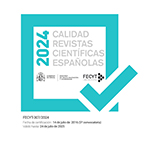Indigenous Calligraphers and Typographers in the New Spain
Abstract
The references about the use of the Latin alphabet by the Native Americans can be found in many books that address the contact and conquest of the New World, from the chronicles of religious orders to the various philological works produced by monks and priests. All of them express, in some way, that the alphabetic system, even if it transformed the original meaning of the Indian texts, worked in favor of the native communities to the extent that these social actors soon made effective use of the new registration system. In the case of the New Spain, indigenous participation in book production was clearly manifested in many ways: not only by their labor as informants, translators and correctors of the missionaries' works, but also because they participated activelly in the visual design and material production of colonial manuscripts and printed books. Taking the phenomenon mentioned above into cosideration, this paper will analyze the role played by calligraphers and typographers in shaping the indigenous written records in alphabetical model, a work that allowed bookish shape of a new American Indian written tradition. To address this issue, first I will do a brief description of calligraphic and typographic training received by Mexican Indians after the American conquest. Secondly, I will give and discuss some concrete examples of manuscripts and printed books where indigenous people participated and, finally, I will introduce a brief summary of the lexicon relative to the written and the book universe, present in the vocabularies for indigenous languages.Downloads
Article download
License
In order to support the global exchange of knowledge, the journal Revista General de Información y Documentación is allowing unrestricted access to its content as from its publication in this electronic edition, and as such it is an open-access journal. The originals published in this journal are the property of the Complutense University of Madrid and any reproduction thereof in full or in part must cite the source. All content is distributed under a Creative Commons Attribution 4.0 use and distribution licence (CC BY 4.0). This circumstance must be expressly stated in these terms where necessary. You can view the summary and the complete legal text of the licence.











